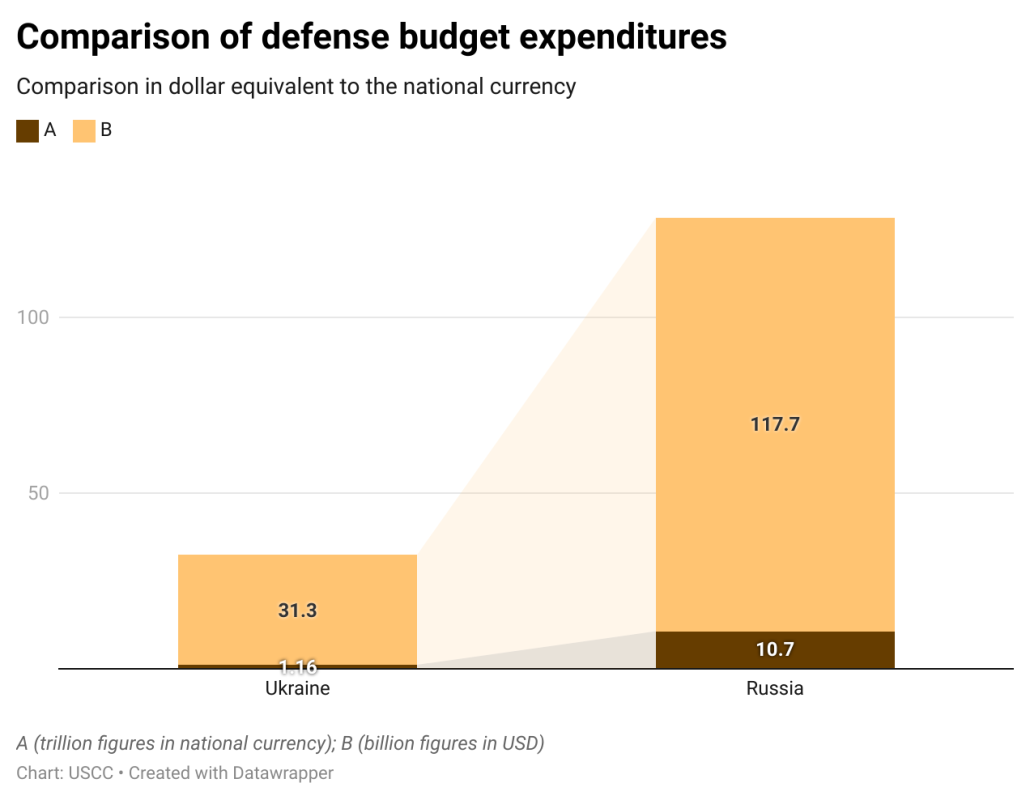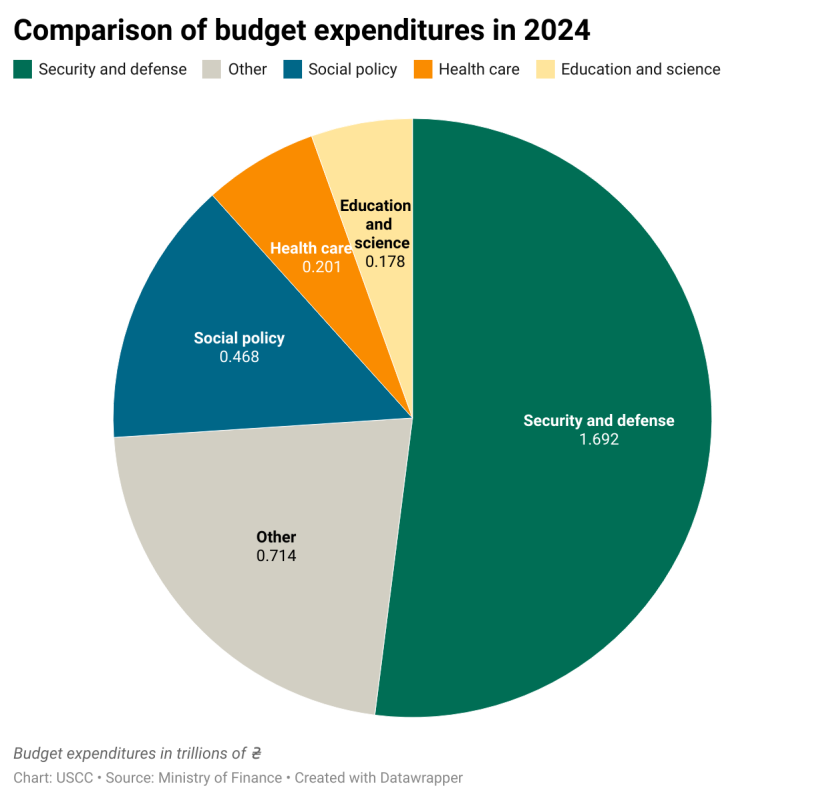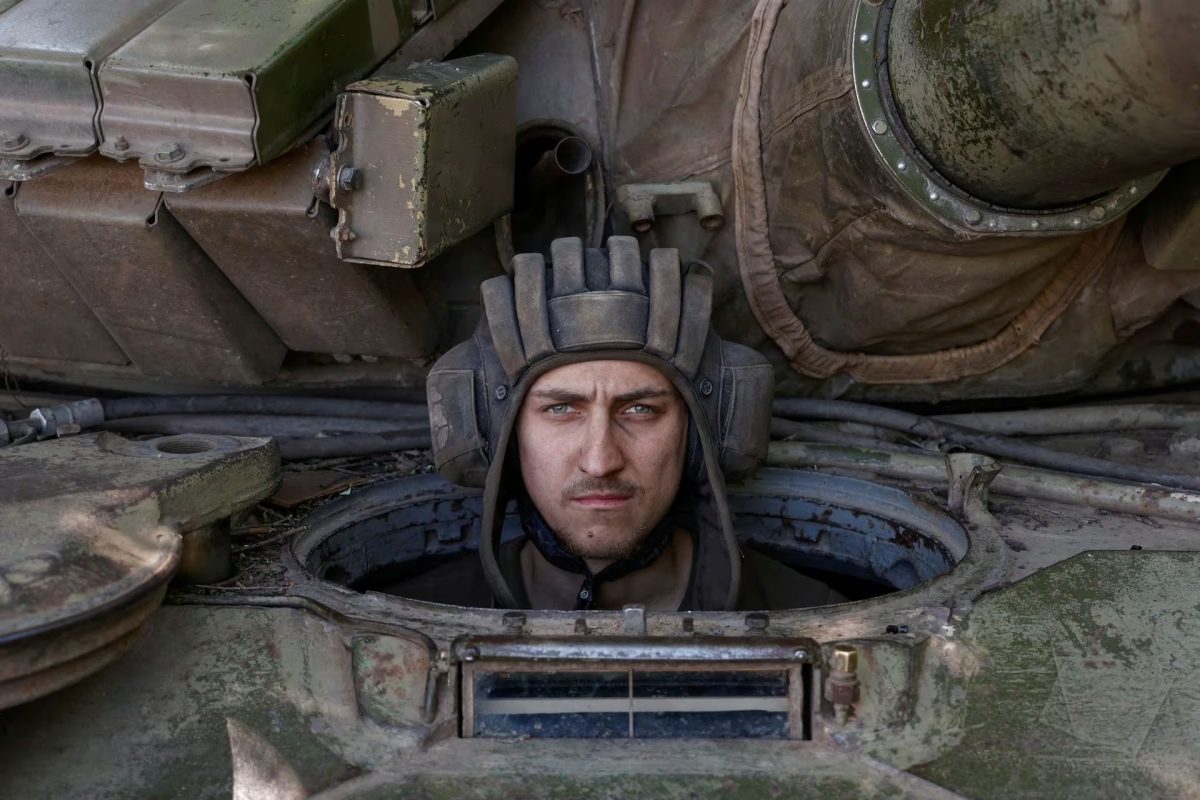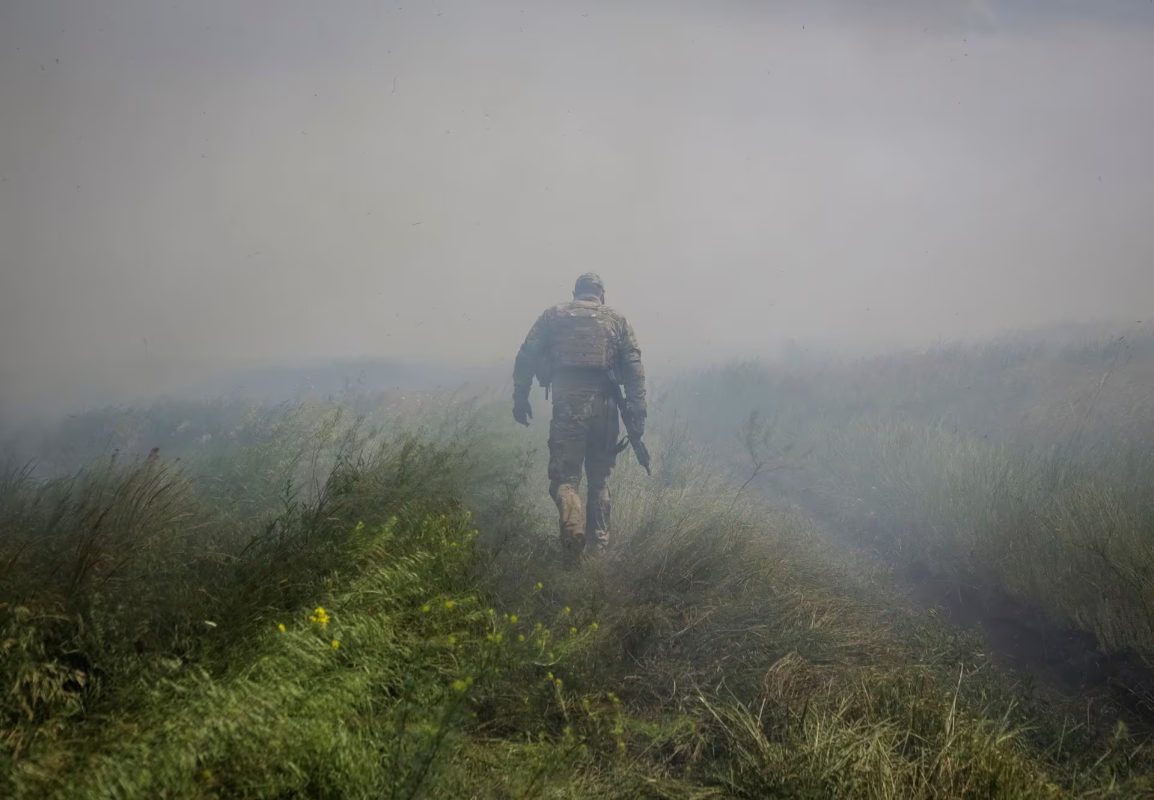Photo – Reuters
Financial and military assistance to Ukraine is an investment in the security of the civilized world. Reducing the amount of allied assistance could be crucial for Ukraine in 2024. The Analytical Department of the Ukrainian Security and Cooperation Center has prepared a detailed prediction of Western aid and Ukraine’s strategy from open sources.
UKRAINE’S BUDGET FOR THE WAR
A full-scale invasion deals critical blows to Ukraine’s economic sector: the occupied territories of the east and south, blocking of trade by sea, outflow of labor resources abroad, and attacks on critical infrastructure worsen the macroeconomic situation in the country. Financial support from allied countries is critical to maintain Ukraine’s stable functioning during the war, as it will be throughout 2023.
In 2024, the law “On the state budget of Ukraine for 2024” envisages revenues of UAH 1.7 trillion ($45.9 billion). Expenditures and loans amount to UAH 3.3 trillion ($87.7 billion).
Security and defense spendings remain the largest category of Ukraine’s budget. In 2024, it is planned to spend UAH 1.6 trillion ($43.2 billion) or 21.6% of GDP, of which UAH 1.16 trillion ($31.3 billion) will constitute expenditures of the Ministry of Defense. The specialized ministry will receive UAH 1 trillion 164 billion (-5.5%), the SBU – UAH 35.1 billion (+11%), the Main Intelligence Directorate – UAH 18.1 billion (+11.7%), the Foreign Intelligence Service – UAH 6 billion (+9.3%), and the National Security and Defense Council – UAH 313.9 million (+11.2%). The budgeted expenditures for the production of weapons and ammunition amount to UAH 55.8 billion, and another UAH 48.1 billion is planned to be spent on the purchase of drones.

It is quite possible that spendings on defense will increase to a record 1.9 trillion hryvnias, as the budget will be amended in 2024, as it was in 2023. The existing amount should already be added to the defense budget revenues received as a result of the redistribution of personal income tax (PIT), according to which a portion of the tax from local budgets will be redirected to the state budget.
According to the Law “On Personal Income Tax”, about UAH 90 billion ($2.4 billion) will be distributed as follows: UAH 43 billion each to the State Special Communications Service for the production of drones and to the Ministry of Strategic Industry for the deployment of ammunition and weapons production, and another UAH 10 billion will be distributed among military units in proportion to the personal income tax paid.
The second largest category of state budget expenditures constitutes the social sector. Expenditures on it in 2024 will amount to UAH 469.72 billion ($12.6 billion). Most of the funds will traditionally go to cover the Pension Fund’s deficit (UAH 321.76 billion). In addition, the budget will spend almost UAH 50 billion on subsidies, and UAH 5.8 billion on social protection for people with disabilities. The planned increase in spending on the Ministry of Strategic Industries is also important – UAH 56 billion (+617.8%). The Ministry is directly responsible for the formation and development of the state industrial and military-industrial policy, policy in the field of defense procurement and the defense industry.

In 2024, same as in the previous 2 years of full-scale war, all taxes collected domestically will be used for military purposes. All other expenditures will be financed by funds from the international partners. The expected deficit of the Ukrainian state budget in 2024 is at UAH 1.59 trillion ($42.9 billion) or 20.4% of GDP. The state debt will increase to UAH 8.18 trillion (in national currency), which will exceed 104% of GDP.
SUPPORT FROM ALLIES
Financial inflows from Ukraine’s partners are critical for the functioning of the state and maintaining macrofinancial stability in the coming year. The Ukrainian government estimates that in 2024, Ukraine will need to attract $41 billion in international financing to cover the budget deficit.
Since the start of the full-scale invasion, Ukraine has already raised about $65 billion of international aid in the form of soft loans and grants. Ukraine’s largest external donors are the US, the EU, and the IMF. In addition, the Ministry of Finance is raising funds from the governments of Canada, Japan, the United Kingdom, Germany, and a number of other countries. These amounts are much smaller compared to the financial support of the key donors, but they are necessary for the functioning of all spheres of society.
The main threat to the Ukrainian budget in 2024 will be the stability of Western financial assistance. It is not fully clear whether Ukraine will be able to count on the funds envisaged in the state budget if international financial assistance decreases. For example, this year we have already received $35 billion from our allies, but the needs by the end of the year are $45 billion. Accordingly, the government is now looking for ways to raise an additional $10 billion by the end of the year.
The Ukrainian government warns that if Ukraine does not have enough resources to finance the state budget deficit in 2024, it will lead to negative economic consequences not only in Ukraine but also in Europe. Due to rising food and energy prices, the poverty rate in the country will also increase, which is likely to trigger a new round of migration to Europe.
It is worth noting that international visits and negotiations contribute to the fact that the European Commission is considering all possible ways of financing Ukraine. At the same time, it is counting on the EU Council to adopt the Ukrainian Fund, which should become a source of financial support in 2024-2027. The European Parliament adopted the relevant decision to establish the fund on October 17. In total, the Ukrainian Fund will provide 50 billion euros of assistance to support the restoration, reconstruction and modernization of Ukraine. The European Commission recognizes that funding problems may begin in the new year, but does not predict a catastrophe.
The Ukrainian Fund may not be approved in time due to Hungary’s veto, but the EU has a plan to circumvent the possible veto by having EU governments create their own aid packages for the required amount. This may take a long time, while Ukraine needs funding urgently, from the beginning of the year.
DEFENSE AND OFFENSE CAPABILITIES
The largest war of the 21st century poses great threats and significant losses for both sides, Ukraine and Russia. Tangible losses in equipment and manpower require finding ways to restore them. As we wrote earlier, despite the heavy losses, Russia still has large stocks of Soviet equipment and does not neglect new waves of hidden mobilization.
Read also: To Be Continued: Assessment of Russia’s Military Capabilities on the Eve of 2024
Ukraine, on the other hand, is largely forced to rely on allies for military equipment. The volume, quality, and timeliness of the assistance provided have a significant proportional impact on the course of the Russian-Ukrainian war. Therefore, against the backdrop of all the threats facing Ukraine’s military and political leadership in 2024, a potential reduction in military assistance and its extension over time seems to be perhaps the most dangerous option, as it could significantly worsen the balance of power at the frontline.
Military assistance provided by Western allies helped the Ukrainian Defense Forces gain an advantage at different stages of the war. According to Kiel Institute estimates, between February 24, 2022 and July 31, 2023, Ukrainian allies provided military assistance worth €89.29 billion, and as of December, total military assistance exceeded €90 billion.
In 2022, Ukraine received more than 117,500 units of weapons, military equipment, and munitions from Western partners only. In total, according to official data from the Ministry of Defense, Ukraine has produced, ordered and received (including international assistance) in 1.5 years:
- more than 6,500 armored vehicles: tanks, combat vehicles, armored personnel carriers and armored vehicles;
- over 4.5 thousand artillery systems, including mortars;
- more than 7 million artillery shells, mines, tank shells and MLRS;
- about 3,500 air defense systems, including man-portable air defense systems;
- more than 2 thousand trucks;
According to NATO Secretary General Jens Stoltenberg, through a U.S.-led contact group, NATO allies and partners have provided Ukraine with more than 1,550 armored vehicles. Allies are also set to deliver, or have already delivered, at least 730 Soviet- and Western-made tanks, such as: Leopard 2/1, Abrams M1A1, Challenger 2, Strv-122.
Development of the Ukrainian defense industry
Since Ukraine cannot depend solely on military assistance from its partners in a war, the government leadership continues to develop the Ukrainian defense industry. Of course, to the extent possible in a full-scale war, when every region of Ukraine is within range of the enemy’s long-range missiles and drones. As a result, dozens of agreements have been signed with leading defense companies, significantly increasing the volume of orders for the production of military products in Ukraine.


Ukrainian drone with artificial intelligence “SAKER SCOUT”. Source – Ministry of Defense of Ukraine
The Ukrainian defense industry is currently focused on the production of its own UAVs and artillery ammunition. For the whole of 2023 it is planned to increase production by 62% compared to last year. Ukraine produces mortar shells, artillery and tank shells in cooperation with foreign partners. As for UAVs, their production has already increased 100 times compared to 2022.
In 2023, a Ukrainian military-industrial complex enterprise launched mass production of a new kamikaze drone capable of hitting targets at a depth of up to 1,000 kilometers. In 2024, it is planned to increase spending on the production of unmanned vehicles by at least 45%, or 43 billion hryvnias ($1.1 billion), while Russia, which also pays attention to its own drone production, has budgeted 66 billion rubles ($735.8 million) for this purpose.
Critical need for artillery shells
For Ukraine’s defense capability, it is strategically important to have a constant supply of 155 mm artillery shells, as artillery causes the greatest losses in equipment and personnel of the Russian army, allowing for effective offensive and defensive actions.
A key factor for the Ukrainian Armed Forces is high-quality counter-battery combat. The Russian army has a superior number of artillery systems and uses the tactic of a “rampart of fire”. Therefore, Ukraine is forced to make the most efficient use of the available artillery and a limited amount of ammunition.
Based on photographic evidence only, Ukrainian forces have already destroyed at least 1,000 pieces of Russian artillery of various types and calibers, including rocket artillery. According to the General Staff of the Armed Forces of Ukraine, since the beginning of the summer offensive, Ukrainian forces have increased their firepower many times over, and the number of destroyed Russian artillery has increased several times. As a result, the number of destroyed Russian artillery since June 2023 has been at least 500 units per month, and in August the number of destroyed Russian artillery reached a record high of 947 units.
The effectiveness of the Ukrainian artillery is due to the high level of training of the military, and the quality and quantity of Western-made artillery weapons.

Ukrainian defender at a position in Donetsk region. Source – Reuters
In addition, in 2023, Ukrainian forces for the first time were able to use Himars missile systems for counter-battery combat at maximum range. Thus, Ukraine was able to achieve conditional parity with the enemy’s artillery, which is numerically superior to Ukraine’s, by using fewer, better and more accurate means of fire.
Increasing the production capacity of allies
In the new year, Ukraine faces the threat of Russia restoring its superiority in artillery by multiplying the amount of ammunition the enemy produces, both domestically and abroad. The United States and its partners have sent more than 2 million of the 155 mm artillery rounds to Ukraine to repel the Russian invasion since February 2022, while Russia has probably spent 10 to 11 million rounds during this time.
Unfortunately, European and American manufacturers are currently unable to provide the necessary production volumes of the 155-caliber ammunition. The European Association of Aerospace, Security and Defense Industries notes that the defense industry has already significantly expanded its production capacity and increased production as much as possible in adverse conditions.
But even so, Europe will not be able to send 700,000 shells out of the promised 1 million that were supposed to arrive in Ukraine in March 2024. Of course, this amount of ammunition will be produced and sent to Ukraine, but critical time may be lost. Already in the fall of this year, supplies of artillery shells to Ukraine from partners decreased by 30%.
DECLINE IN MILITARY AID AND SUPPORT FOR UKRAINE
The vast majority of senior political and military leaders in the West understand that investing in Ukraine’s defense capabilities is strategically important for the future of global security. This was openly stated by Lloyd Austin when he visited Kyiv and appealed to the US Congress to approve military aid to Ukraine, calling it a “smart investment.”
The leaders of the allied countries openly declare their absolute faith in Ukraine in the war against Russia, assuring that they will continue to support it as long as necessary. However, in fact, already at the end of 2023, there was a decline in the volume of arms supplies, in particular from the United States.
From August to the second half of November, Ukraine received a total of about $2.4 billion in military assistance packages from the United States, which is equivalent to one package that Ukraine received from Washington in July 2023 – $2.5 billion, or in June – $2.4 billion. The US military aid package in November ($100 million) is the smallest since February 24, 2022. Prior to that, the smallest aid package was in May 2022 worth $300 million.
Such a decline in support at the end of 2023, primarily from the United States, cannot but worry the Ukrainian leadership. The electoral mood of Western societies, the elections in the EU and the US in 2024, can significantly affect the balance of political forces in the Western world, and thus support for Ukraine. Especially on the eve of 2024, when Russian troops are trying to seize the initiative on the battlefield by conducting offensive actions on several fronts, and the Russian authorities have increased spending on the war at a record high to create an image of victory for President Putin, against the backdrop of the presidential elections in March 2024.

Commander-in-Chief of Ukrainian Armed Forces Valerii Zaluzhnyi. Source – The Economyst
In his article “Modern positional warfare and how to win it” for The Economist, the Commander-in-Chief of the Armed Forces of Ukraine Valeriy Zaluzhny expressed his belief that to get out of the positional form at the current stage of the war, first of all, it is necessary to: gain air superiority; overcome the deeply entrenched system of minefields; increase the effectiveness of counter-battery and electronic warfare; create and prepare the necessary reserves.
However, all of this will be possible for the Ukrainian military only with the support of partners who will be able to increase the volume of military assistance in quality and quantity. Otherwise, the positional stage of the Russian-Ukrainian war will last much longer and will benefit only the Kremlin, which, in turn, can gain a decisive advantage in the war against Ukraine.
SUMMARY
The coming year poses a number of serious challenges for Ukraine and its allies. In 2024, the Ukrainian army and society may find themselves in a difficult situation due to uncertainty about financial and military support. Not least because of the upcoming elections in the United States and Europe, the outcome of which could directly affect military and political support for Ukraine. At the end of 2023, Ukraine has already felt these consequences.
There is no doubt that Russia will try to use the elections to destabilize the domestic political situation in the world, and to strengthen its interests by undermining Western societies and expanding its own network of influence. Despite Ukraine’s deployment of its own military-industrial complex and capacity building, the decline in military support will have a significant impact on the course of the war in 2024. As Russia systematically increases its spending on the war(twice as much as Ukraine allocates for defense), depleting its own resources and those of the enemy, we should strengthen cooperation with the democratic world.
The idea of allies reducing their support for Ukraine is a high-cost mistake. If poverty increases in a country that acts as a shield against terrorists, or if its defense capabilities weaken, it will pose a threat to the whole Europe.

